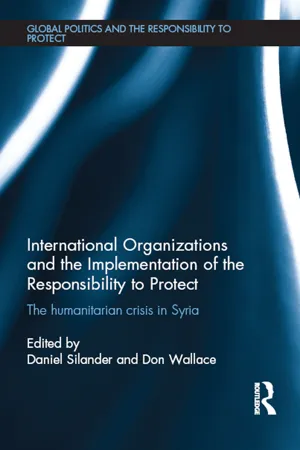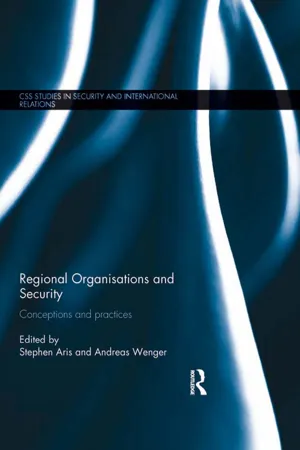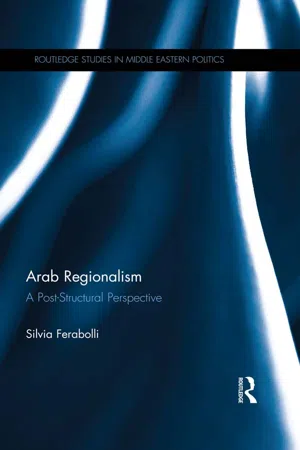Politics & International Relations
Arab League
The Arab League is a regional organization of Arab countries established to promote economic, cultural, and political cooperation. It aims to coordinate the policies of member states and safeguard their independence and sovereignty. The league also addresses regional issues and conflicts, serving as a platform for Arab states to discuss and address common concerns.
Written by Perlego with AI-assistance
Related key terms
1 of 5
6 Key excerpts on "Arab League"
- eBook - PDF
- Publitec Publications(Author)
- 2011(Publication Date)
- De Gruyter Saur(Publisher)
On this occasion Egypt took the lead and invitations were issued to a number of Arab States in order to discuss the possibility of advancing Arab interests by joint colaboration in measures designed to reduce foreign intervention. As a result, the Arab League was formed in 1945, with the States of Egypt, Iraq, the Lebanon, Saudi Arabia, Syria, Yemen and Transjordan as members. At present, they are 22 members with their date of admission: PRESENT MEMBERS The People's Democratic Republic of Algeria (1962) The Kingdom of Bahrain (1971) The Federal Islamic Republic of the Comoros (1993) The Republic of Djibouti (1977) The Hashemite Kingdom of Jordan (1945) The Republic of Iraq (1945) Kuwait (1961) The Republic of Lebanon (1945) The Great Socialist People's Libyan Arab Jamahiriya (1953) The Islamic Republic of Mauritania (1973) The Kingdom of Morocco (1956) The Sultanate of Oman (1971) Qatar (1971) The Kingdom of Saudi Arabia (1945) Somali Democratic Republic (1974) The Democratic Republic of the Sudan (1956) The Syrian Arab Republic (1945) The Republic of Tunisia (1958) The Arab Republic of Egypt (1945) The Republic of Yemen (1945) Palestine (1964) United Arab Emirates (1971) The Council of the League of Arab States which is the supreme organ of the League consists of representatives of all the member States, each of which has one vote, and of a representative for Palestine. The Organisation for the Liberation of Palestine has been nominated to represent Palestine. There are nine permanent committees for political, cultural, economic, social and legal affairs, information, communications, health, petroleum, human rights, all cooperating with the Secretariat General of the League. I. - COUNCILS AND ORGANISATIONS Economic Council: Established in 1953. Joint Defence Council: Established in 1950. Civil Aviation Council: Created in 1965. The International Arab Organisation for Social Defence Against Crime: Created in March 1965. - eBook - ePub
International Organizations and the Implementation of the Responsibility to Protect
The Humanitarian Crisis in Syria
- Daniel Silander, Don Wallace(Authors)
- 2015(Publication Date)
- Routledge(Publisher)
Saikal, 2006 , p. 188). At the time of writing, it is still fair to argue that these issues have not yet been resolved. During the 1940s the idea of rallying Arab countries against colonial rule was growing. A further important regional issue was preventing the Jewish community in Palestine from creating a Jewish state. However, the formation of the League of Arab States did not come into being until just before the end of the Second World War, in March 1945, with six original members: Egypt, Iraq, Lebanon, Transjordan, Syria and Saudi Arabia. The LAS now has 22 members: Algeria, Bahrain, Comoros, Djibouti, Egypt, Iraq, Jordan, Kuwait, Lebanon, Libya, Mauritania, Morocco, Oman, State of Palestine, Qatar, Saudi Arabia, Somalia, Sudan, Syria (at present suspended) Tunisia, United Arab emirates and Yemen.According to Article 2 of the Pact of the League:[T]he purpose of the League is to draw closer the relations between member states and co-ordinate their political activities with the aim of realizing a close collaboration between them, to safeguard their independence and sovereignty, and to consider in a general way the affairs and interests of the Arab countries.(Pact of the League of Arab States, March 22, 1945 , Article 2)The League now has 22 member-states, although Syria has been suspended since November 2011 because of “its failure to end bloodshed caused by brutal government crackdowns on pro-democracy protests” (Batty and Shenker, 2011 ). The Council is the highest body of the League and is composed of representatives of the member-states. A secretary-general within the general secretariat (Pact of the League of Arab States) undertake the day-to-day running of the League.Arrangements for mutual defense and economic cooperation were embedded in a Treaty of Joint Defense and Economic Cooperation among the States of the Arab League in June 1950. The purpose was: - eBook - ePub
- Tawfig Y. Hasou, Hasou(Authors)
- 2019(Publication Date)
- Routledge(Publisher)
Two special annexes of the protocol dealt with Lebanon and Palestine. The independence and sovereignty of Lebanon within its present borders was to be respected by the other Arab states. The second declared Arab solidarity with Palestine and pledged full support to the Palestinian people.A formal Arab conference met in Cairo and signed the pact of the Arab League on 22 March 1945 (see Appendix A). The original members were Egypt, Saudi Arabia, Syria, Iraq, Lebanon, Yemen, Trans-Jordan,59 and a representative for the Palestinians. It should be noted, however, that the legal status of some of these original states, was either only de facto independent or not independent at all. This would explain their reluctance during the preparatory conversations to give up their sovereignty and independence in favour of a full union with a central authority.60 Instead, the conferees agreed to establish a barely loose association for the agreed purpose of ‘strengthening bonds of friendship between the members and the co-ordination of their political action with the object of safeguarding their independence.’Originally, the Arab League comprised three categories of bodies: the council, the specialized commission, and the general secretariat, the last comprised of a secretary-general, assistants, and other officials. The League’s headquarters, as mentioned earlier, was to be in Cairo. The council of the League, however, was the supreme body of the organization. Thus, as noted above, the original members exercised great caution to avoid imposing binding commitments on the members. As an outcome of such consensus, members were free to withdraw at any time. Each state had one vote. The League was made up of a council composed of the representatives of the member states. The council was to have no army or police force, nor any means of making its decisions obligatory for a state. Article 7 of the pact stated that ‘unanimous decisions of the Council shall be binding upon all member states of the League; majority decisions shall be binding only upon those states which have accepted them.’ In other words, each member state was always free to act according to its own will and interest and was not obligated to follow the majority rule.61 - eBook - ePub
International Organizations and The Rise of ISIL
Global Responses to Human Security Threats
- Daniel Silander, Don Wallace, John Janzekovic(Authors)
- 2016(Publication Date)
- Routledge(Publisher)
Chapter 1 ). This then leads on to a discussion of whether or not the League, as presently constituted, can implement the UN policy of R2P. Finally, we outline how the League and its individual states have acted over the problem of the rise of ISIL.The Arab League’s capacities on state/human security
An indicator of the Arab League’s declared capacities is its constitution, the Charter of the Arab League, sometimes referred to as the Pact of the League of Arab States. Through the Charter, the Arab League has primarily a political focus. It is considered as a “loose confederation” of 22 Arab states with a broad mission to improve coordination among its members on matters of common interest (Masters & Aly Sergie, 2014). As a political organization, it was conceived to provide assistance in integrating its members economically and to solve conflicts involving member states without asking for foreign assistance (Stigall & Blakesley, 2015). According to Article 2 of the Charter, the purpose of the Arab League is “the strengthening of the relations between the member states, the coordination of their policies in order to achieve cooperation between them and to safeguard their independence and sovereignty; and a general concern with the affairs and interests of the Arab countries” (League of Arab States, 1945).The institutional structure of the League has two core bodies, the League Council and the Permanent Secretariat, and there are also a number of permanent committees. The 1945 Arab Charter explicitly includes in its mandate the promotion of economic and financial affairs, including commercial relations. Reich (2005) observes that in practice the Arab League has had no significant activity in these specific fields, largely since, despite this Charter-based requirement, none of its committees, subsidiary bodies, or specialized organizations are devoted to trade or commercial relations. - eBook - ePub
Regional Organisations and Security
Conceptions and practices
- Stephen Aris, Andreas Wenger(Authors)
- 2013(Publication Date)
- Routledge(Publisher)
15 Yet, although the creators of the League wanted it to empower sovereignty rather than Arabism, according to Barnett and Solingen, the intensified interactions fostered by its existence inadvertently empowered Pan-Arab norms constraining its members’ sovereignty. All regimes needed to be seen to participate in the League to demonstrate their Arabism to their publics, which expected them to act collectively to protect regional autonomy from (and push for further de-colonization against) Western imperialism and threats from the stronger non-Arab states, above all Israel.The League’s main institutions were a Council that regularly assembles representatives of the member states (foreign ministers, but later supplemented by a more powerful summit of heads of state) and a secretary-general (heading a secretariat) to act as spokesman for the League and to overseas implementation of Council decisions. While these institutions have ensured a durable minimum presence for the League in inter-Arab politics, both their rules and the violations of these rules have kept it weak. The unanimity rule tended to reduce council decisions to the minimum all could agree on and implementation of these depended on voluntary compliance by states; thus, over 50 years the League would pass over 4,000 resolutions touching on collective Arab interests, but, according to Barnett and Solingen, 80 per cent were never implemented.16As regards inter-member conflicts, the use of force between members was prohibited but it took a unanimous decision for the Council to adopt measures against an aggressor – excluding the latter from the vote. If states in dispute accepted arbitration, majority decisions of the council were binding, but since both parties had to consent, such arbitration was often precluded.17 The League has authorized only two peace-keeping missions (1963 in Kuwait, 1976 in Lebanon). To mitigate these weaknesses, the practice emerged of the secretary-general undertaking informal mediation missions and Summits became arenas for reaching consensus. Figures showing that the League successfully mediated only 12 per cent of regional conflicts are skewed, Pinfari argues, because the League is excluded from mediation in the many Arab–non-Arab conflicts; he acknowledges it has been ineffective in dealing with Arab civil wars, intervening in only five of the 22 of them, but presents data showing the League mediated in 60 per cent of the Arab world’s ‘minor’ conflicts (resulting in less than 1,000 deaths) or political crises, at least contributing to their resolution in 45 per cent of them and being the primary cause of their resolution in five instances (25 per cent).18 - eBook - ePub
Arab Regionalism
A Post-Structural Perspective
- Silvia Ferabolli(Author)
- 2014(Publication Date)
- Routledge(Publisher)
6 the Arab League has managed to project itself as the international representative of the Arab states and has acted as a unified group in several international forums, summits and conferences.The role the LAS plays in projecting an Arab collective identity internationally is constitutive of the reiterative regional discursive practices that make the Arab region possible. It is the study of situations in which the LAS acted as a group and was recognized as a single actor by members of the international community thus further defining the physical-political and the social-historical boundaries of the Arab region that the following section now considers.The LAS and the Arab boycott against Israel
Perhaps the most widely known example of Arab collective action coordinated by the LAS is the organization and maintenance of the Arab boycott of Israel. Although some authors claim that economic boycotts had been used by Arabs against the Jewish community in Palestine since the end of the nineteenth century, in fact the Arab boycott against Israel, as it is known today, was brought about by a formal decision of the LAS in 1945 , which eventually became “the most institutionalized and comprehensive system of economic sanctions ever imposed against a people and a state” (Feiler 1998
Index pages curate the most relevant extracts from our library of academic textbooks. They’ve been created using an in-house natural language model (NLM), each adding context and meaning to key research topics.





